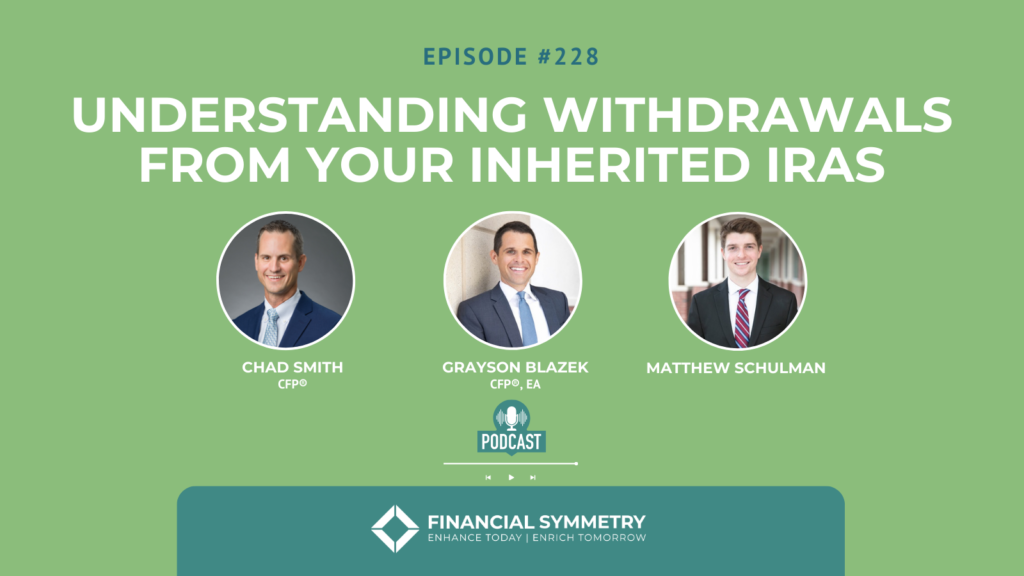An inherited IRA is essentially an IRA received by a beneficiary after the original owner passes away. Whether it’s a spouse, child, or another loved one, the key characteristic of an inherited IRA is that it transitions ownership upon death.
As Grayson Blazek explains, the funds are transferred intact, but the way you handle and withdraw these funds comes with specific rules and timelines. Grayson and Matthew dig into the new rules in this episode.
Distribution Rules for IRAs
Standard IRAs and inherited IRAs have different distribution rules. For a standard IRA, you’re not required to take distributions until the year after you reach age 73.
In contrast, an inherited IRA has varied and more immediate requirements, depending on your relationship to the original owner and the timing of the inheritance. This distinction is crucial for proper planning and minimizing tax liabilities.
The SECURE Act segregated beneficiaries into two categories: eligible and non-eligible designated beneficiaries.
Eligible Designated Beneficiaries: These include the decedent’s spouse, a minor child, or a beneficiary less than 10 years younger than the decedent. They have more options and longer time frames for withdrawing funds.
Non-Eligible Designated Beneficiaries: This broader group usually includes adult children, siblings more than 10 years younger, and friends. They fall under the strict 10-year rule, which offers less flexibility.
In this episode, we’re going to concentrate on how non-eligible designated beneficiaries can plan for their financial future when considering inherited IRAs.
The Impact of the SECURE Act on Inherited IRAs
One of the major issues we discuss is the impact of the SECURE Act, passed in 2019 and effective from January 1, 2020. This Act overhauled the distribution requirements for inherited IRAs, lumping most beneficiaries into something called a “10-year rule.”
Before this change, beneficiaries could use the “stretch IRA” method to take distributions over their lifetime, therefore spreading the tax burden. Post-SECURE Act, non-eligible designated beneficiaries must withdraw the entire account within 10 years of the original owner’s death. This change can be tricky to navigate if you’re not fully informed.
Strategic Planning for Withdrawals
For non-eligible designated beneficiaries, the 10-year rule is crucial. If the decedent has already reached the “required beginning date” for their own distributions (the year they turn 73), beneficiaries must continue to take yearly required minimum distributions (RMDs) plus ensure the entire amount is withdrawn within the 10-year period.
Grayson provides several examples illustrating how these rules might play out. The goal is to successfully navigate these requirements while optimizing for tax efficiency. If your inheritance coincides with high-income years, spreading distributions over the decade or deferring them until lower-income years could significantly reduce your tax burden.
For example, a 45-year-old middle–career professional might defer distributions if they’re expecting to retire soon, thereby reducing the tax hit during high-earning years. A student or someone temporarily out of work might accelerate distributions while in a lower tax bracket.
Generational Planning
Grayson encourages open family discussions about wealth and estate planning, which, though uncomfortable, can ensure tax-efficient transitions and family wealth preservation. Engaging financial planners to align your will and beneficiaries with current laws can avoid unnecessary stress and tax liabilities. Inherited IRAs, though complex, can be effectively managed with the right knowledge and planning.
Outline of This Episode
[4:50] Differences between eligible and non-eligible designated beneficiaries
[6:16] Why it’s important to list IRA beneficiaries to avoid tax inefficiency
[8:19] The year that you inherit an IRA impacts that distribution requirement
[10:18] Discussing inheritance can lead to meaningful conversations that make financial planning easier
[14:17] You need to continue taking the required minimum distribution (RMD) if the decedent began them already
[16:00] How to handle a 10-year account withdrawal strategy
[22:07] Key takeaways about your withdrawal options with the new rules as a non-eligible designated beneficiary
Resources & People Mentioned
